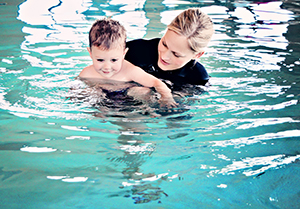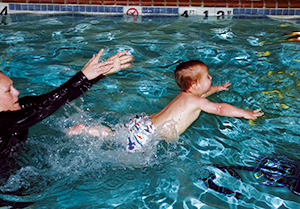Infant Swim Rescue
 Marcy Toler learned the value of infant swim techniques when her own
Marcy Toler learned the value of infant swim techniques when her own
child was young. “When our son was 15 months old, he could climb out of his
crib and open doors,” she said. “We had a pond in our back yard and it
terrified me to think he could get to that pond and drown. So I signed up with the only
instructor in OKC at the time and after his first lesson, I knew I wanted to be
an Self-Rescue instructor.”
There
is a serene look on babies’ faces when they float like chubby little creatures
in water. All the pictures show the same expression—relaxation, wonderment,
that crooked baby smile and calmness. They simply take to water. And because
more than 200,000 infants and toddlers have learned Infant Self-Rescue since
1966, more than 788 cases have been documented of children using Infant
Swimming Resource Self-Rescue to save themselves
from drowning.
Founded in 1966 by Dr. Harvey
Barnett, ISR pioneered survival swimming lessons for infants and young
children, and in Oklahoma City’s metro area, babies are learning to save
themselves. “Our team of nearly 450 highly trained ISR instructors nationwide provides
the safest and most effective survival swimming lessons available,” said Marcy
Toler, a certified ISR instructor in Edmond. “Today, our mission—Not One More Child Drowns—is the
foundation of everything we do.”
For Toler, the instruction was a
work of passion. Babies learn to feel comfortable in water, and they also learn
to save themselves from the unspeakable tragedy of drowning. “Not only is
drowning the second leading cause of unintentional injury related death in
children under the age of four, 70 percent of preschoolers who drown are in the
care of one or both parents at the time of the drowning and 75 percent of them
were missing for five minutes or less,” Toler said. “Why not add another layer
of protection to arm children with the skills to save themselves if they find
themselves in the water unsupervised?”
 During the lessons, children
During the lessons, children
ages 6 to 12 months learn to roll onto their backs to float and simply breathe
until help arrives. It’s a basic move, but for babies, learning and maintaining
the position is essential. Introducing a baby to water is the essence of
learning. “Every child is different. Some children are happy to be in the
water. Some are nervous. Some cry. But they all end up fully skilled and armed
with techniques to save themselves,” said Toler. “I’ve taught over 500
children, and it is still truly amazing to me every time I get to see a child
master a skill.”
ISR����s Self-Rescue survival
swimming program is a four to six week course held five days a week for 10
minutes each day. Children may begin lessons at 6 months of age until 6 years
of age. The lessons emphasize health, ongoing program evaluations and parent
education.
 Each lesson is different. Babies
Each lesson is different. Babies
learn to hold their breath underwater, roll onto their backs and float.
Children ages 1 to 6 learn the same skills, but also how to swim to a place in
which they can crawl to safety, a maneuver called the ISR swim-float-swim sequence.
Because 83 percent of children who drown are fully clothed at the time, the
final week of lessons allows students to practice their self-rescue techniques
in summer and winter clothes.
“It’s never too late to get your child into
lessons— the sooner, the safer,” she said. “Several children already saved
themselves this year.”
Certified instructors of ISR can be found at www.infantswim.com.




